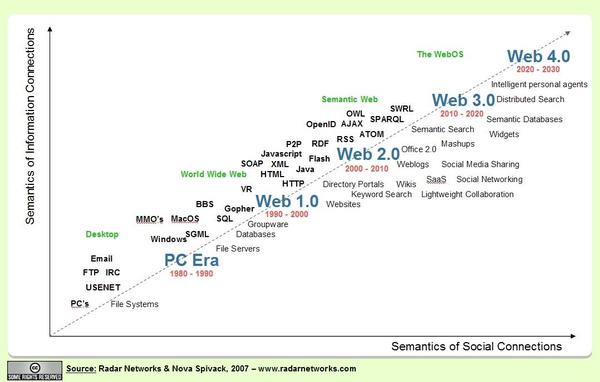| Web 1, 2, 3 and 4 | 2008-02-23 17:19 4 comments |
 by Flemming Funch Nova Spivack has a nice video presentation, of the Semantic Web, and a suggestion of what would be called Web3.0 and Web4.0. For dummies. Well, for a group of French business school students, at least, but it means he explains it in simple terms. He labels Web1.0 as the "Worldwide Web", Web2.0 as the "Social Web", Web3.0 as the "Semantic Web", and Web4.0 as the "Intelligent Web". The graphic there is older than what he uses in the video, so the labels are a little different. Of course, since it hasn't happened yet, nobody can be sure what it will be or what it will be called, but this makes very good sense. Particularly, it makes sense to plot it on such a graph, where the Y axis is connections between information, and the X axis is connections between people. Web 2.0 connects people and information pretty well, but it is based on relatively crude methods, such as matching people and information up based on keyword searches. The Semantic Web implies that information is encoded with metadata, so that for example a search for the animal "jaguar" is different from a search for "jaguar", the car brand, or "jaguar", a version of Mac OSX. I.e. the data is more structured, so you would be able to get more precise and appropriate answers to queries, and you can ask for more complicated stuff. In The Intelligent Web, it would all become an integrated whole, like an operating system. It wouldn't matter where something is stored, by what program, on what server. It would be like "Computer, give me ...", and it will find it. And that this web would be more proactive in getting you stuff without you having to first ask for it. Of course that's all rather fuzzy, and he places that in 2020-2030. And, of course, nobody has any real good answer to who's going to encode everything with metadata for Web3.0, and nobody has invented anything that looks much like the Artificial Intelligence needed for Web4.0, so it is all up in the air. But it is a good and simple road map. |